Rhodes’ Apostles – who were they and what happened to them?
Sources
I have used mainly Robert Cary’s book The Pioneer Corps and Colonel A.S. Hickman’s book Men who made Rhodesia and as sources and supplemented them with others listed under References. Hoste calls them ‘Apostles,’ Hickman calls them ‘Disciples.’
For a full list of those who made up the Pioneer Corps see the article The Pioneer Column’s march from Macloutsie to Mashonaland under Harare on the website www.zimfieldguide.com
Contemporary references
Henry Francis ‘Skipper’ Hoste in his book Gold Fever edited by his grandson N.S. Davies refers to the Apostles joining the Pioneer Column on the 14th July 1890 as they built a drift across the Tshabezi river,[i] but their names are only given in his diary.
In his diary[ii] he writes: “The Pioneer Column had also a slight addition to its numbers in the ‘Twelve Apostles’ though as a matter of fact there were thirteen of them. They were thirteen young fellows selected by Rhodes himself at Kimberley. They were supposed to act as the Administrator’s bodyguard, but as the Administrator had not yet taken over his job, a bodyguard would be no use to him. Heany and I[iii] therefore divided them up between us. Their names were F.W. Adcock, P.W. Campbell, T.J. Christison, A. Eliot, W.L. Cornwall, R.T. Coryndon, W.D. Durell, F. Ehlert, H.W. Featherstonehaugh, J. Grimmer, J.M. McRobert, B.E.A. O’Meara and W.K. Steir. On our arrival at our destination [Mt Hampden, later changed to Salisbury, the site of present-day Harare] the first civil servants were selected from them."
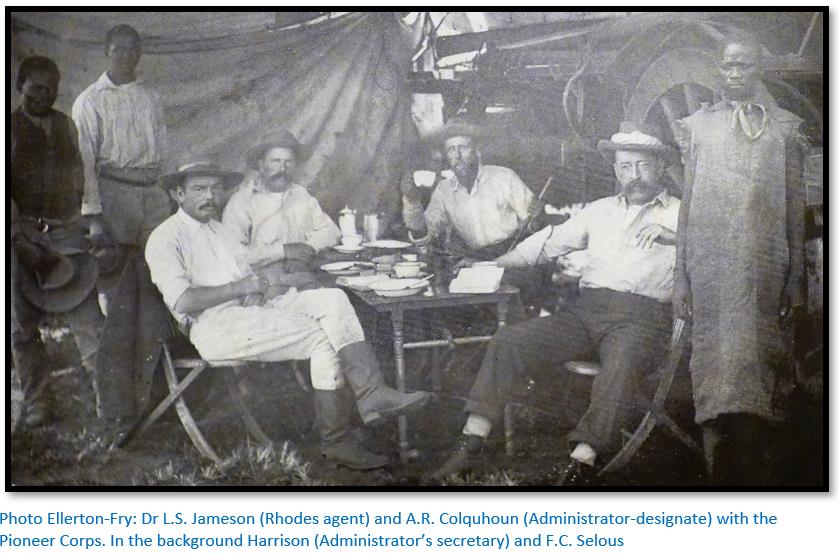
Often referred to as the ‘Twelve Apostles:’ Hoste believed there were thirteen, Hickman states there were fourteen ‘Disciples’[iv] and I believe there were fifteen in all! Of the fifteen names below, the two names that Hoste does not list are W.M. Nesbitt and G.E. Seward.
The ’Apostles’
Below is a table of those I believe were chosen by Rhodes as the future administrators of Mashonaland sorted by their British South Africa Company Police (BSA Co) nominal roll numbers and generally referred to as the ‘Apostles’:
| The Apostles | BSA Company Police No. | Attested date | Rank | Troop | Discharge date | Attested date | Pioneer Corps No. | Troop | |
| 1 | Adcock, R.W. | 7 | 10/12/1889 | Sgt | B | 13/07/1890 | 14/07/1890 | 162 | B |
| 2 | Campbell, P.W. | 483 | 1/04/1890 | Tpr | B | 13/07/1890 | 14/07/1890 | 163 | B |
| 3 | Christison, T.J. | 484 | 1/04/1890 | Tpr | B | 13/07/1890 | 14/07/1890 | 164 | A |
| 4 | Coryndon, R.T. | 485 | 1/04/1890 | Tpr | B | 13/07/1890 | 14/07/1890 | 166 | A |
| 5 | Cornwall, W.L. | 486 | 1/04/1890 | Tpr | B | 13/07/1890 | 14/07/1890 | 165 | A |
| 6 | Durrell, W.D. | 487 | 1/04/1890 | Tpr | B | 13/07/1890 | 14/07/1890 | 167 | B |
| 7 | Eliot, A. | 488 | 1/04/1890 | Tpr | B | 13/07/1890 | 14/07/1890 | 169 | B |
| 8 | Ehlert, F. | 489 | 1/04/1890 | Tpr | B | 13/07/1890 | 14/07/1890 | 168 | B |
| 9 | Featherstonehaugh, H.W. | 490 | 1/04/1890 | Tpr | B | 13/07/1890 | 14/07/1890 | 170 | B |
| 10 | Grimmer, J.R. | 491 | 1/04/1890 | Tpr | B | 13/07/1890 | 14/07/1890 | 171 | B |
| 11 | MacRobert, J.M. | 492 | 1/04/1890 | Tpr | B | 13/07/1890 | 14/07/1890 | 172 | A |
| 12 | Nesbitt, W.M. | 493 | 1/04/1890 | Tpr | B | 13/07/1890 | 14/07/1890 | 173 | A |
| 13 | O'Meara, B.E.A. | 494 | 1/04/1890 | Tpr | B | 13/07/1890 | 14/07/1890 | 174 | A |
| 14 | Seward, G.E. | 495 | 1/04/1890 | Tpr | B | 13/07/1890 | 14/07/1890 | 176 | A |
| 15 | Steir, W.K. | 496 | 1/04/1890 | Tpr | B | 13/07/1890 | 14/07/1890 | 175 | B |
Why I think there were Fifteen Apostles
I think there is a strong argument for all the fifteen young men listed above qualifying as Rhodes’ Apostles because:
- Their BSA Co Police attestation date is all the same (1 April 1890) and their nominal numbers all run consecutively (483 – 496) except for R.W. Adcock who attested on 10 December 1889 (No 7)
- All fifteen transferred from the BSA Co Police and were attested into the Pioneer Corps on the same day (14 July 1890)
- All fifteen have consecutive Pioneer Corps nominal roll numbers (162 – 176) including for Adcock.
The Pioneer Corps member who attested prior to R.W. Adcock No 162 was William Drabble No 161 and he attested on 3 July 1890 – eleven days before the Apostles.
The Pioneer Corps member who attested after G.E. Seward No 176 was William Mackay No 177 and he attested on the 8 August 1890 – twenty-five days after the Apostles.
The Apostles – a brief summary of their lives
(1) Adcock, Roger William (1867 – 1939) No 162
Joined the Pioneer Corps on 14 July 1890 having previously been attested into the BSA Co Police (No 7) as one of Rhodes ‘Apostles.’ Appointed to B Troop.
He joined the British South Africa Company Police (BSA Co Police) before any of the others on 10 December 1889 – after the Royal Charter had been granted to the BSA Co in October 1889, but before Frank Johnson had signed the contract for the occupation of Mashonaland on 1 January 1890. A Sergeant at the time of transfer on 14 July 1890, he reverted to Trooper No 162 at his own request.
Hickman states he was discharged on the day the column reached Fort Salisbury on 12 September 1890, presumably so he could begin administrative duties for the BSA Co.
Born Bethlehem, Orange Free State 27 July 1867. He did not stay with the BSA Co more than a few months as in 1890 – 91 he was prospecting as part of a syndicate of six ex-Troopers at Gadzema, 11 km north of Chegutu (formerly Hartley) where the Giant Mine began operations.
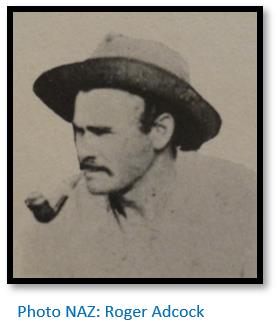
Adrian Darter writes in his book The Pioneers of Mashonaland: “Roger Adcock also develops an antipathy for hawks. He had mended a favorite pipe by drawing a piece of hide over it obtained from the tail of a buck and set it in the sunlight to dry and contract round the stem. A hawk swooped down in predatory flight and carried off the pipe. From that day, Adcock’s shotgun was constantly employed in the production of these offal-lifters...”[v]
Fought in the Anglo-Boer War as Chief Transport Officer with the rank of Captain. Carried on business in Johannesburg and died there on 15 June 1939.
His medals: British South Africa Company Medal 1890-97, reverse undated, 1 clasp, Mashonaland 1890 (Tpr., Pioneers); Queen’s South Africa 1899-1902, 3 clasps, Cape Colony, Orange Free State, Transvaal (Capt., A.S.C.); King’s South Africa, 2 clasps (Capt., A.S.C.), mounted court style for display, sometime plated, otherwise very fine and better were sold by Dix, Noonan Webb in 1991.
Married Cecilia Mary Welch on 17 November 1906 and had a son.
(2) Campbell, Patrick W (1863 – 1900) No 163
Joined the Pioneer Corps on 14 July 1890 having previously been attested into the BSA Co Police (No 483) as one of Rhodes ‘Apostles.’ Appointed to B Troop and then temporarily to A Troop next day as a Trooper. Leonard refers to him as a Corporal in C Troop, but this is probably a print error, as Leonard knows that Campbell is the Administrator’s (A.R. Colquhoun) clerk based in Salisbury and that C Troop was left at Victoria to build a fort.[vi]
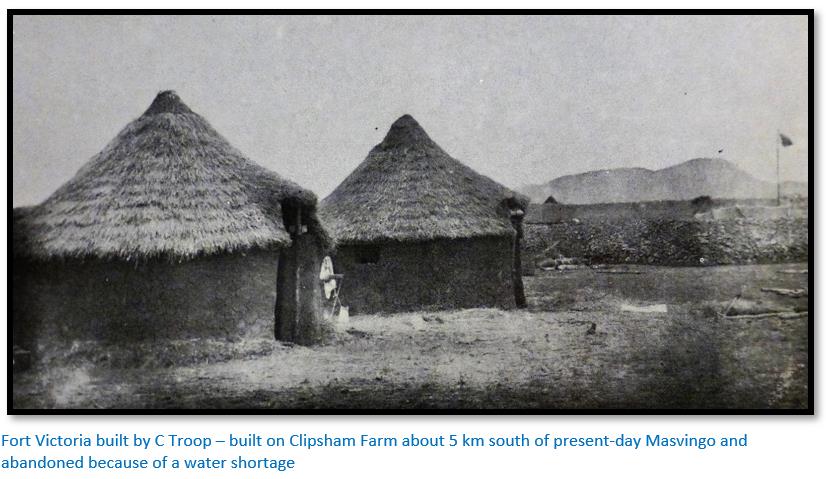
Previously employed by the Kimberley Central Diamond Mining Company (KCDM) that belonged to the Barnato Brothers and associates as it was merging with Rhodes De Beers Mining Company to form De Beers Consolidated Mines.
Born in England in 1863 and educated at Wellington College, he married Beatrice Stella Tanner in 1884 who later became celebrated as the most accomplished actress Mrs Pat Campbell. They had two children, Allan ‘Beo’ and Stella.
He left England for his health and to seek his fortune going to Australia for a short period, before being drawn to the diamond discoveries in South Africa and initially joining KCDM. His interesting letters are included in the longer article on the website.[vii]
At Fort Salisbury he was clerk to A.R. Colquhoun – the Administrator - and accompanied the party to sign a concession with Chief Mutasa in Manicaland before taking despatches to Rhodes and Sir Henry Loch in Bechuanaland. He wrote in a letter: “In eleven days, I rode a distance of 600 miles to Palapye, the chief Mangwato town, where I met Mr Rhodes and the Governor, Sir Henry Loch.“
On Patrick Campbell’s return from Kimberley he confirms to Leonard the rumours of a rift between Colquhoun and Jameson. Campbell tells Leonard that Jameson has the power to get rid of Colquhoun and Leonard wonders why he does not: “Difficulties in the way, I suppose…Easy enough to say that honesty is the best policy but carrying it out is putting quite another complexion on the matter.”[viii]
After joining a syndicate that prospected on the Kaiser Wilhelm gold field at present-day Makaha, he joined another ‘Apostle’ W.L. Cornwall and H.J. Morris in a business partnership - W.L. Cornwall, Secretarial Agent, Auctioneer and Sworn Appraiser.
Extracts from a number of his letters are copied into the article Patrick Campbell, husband of Mrs Patrick Campbell who went to Mashonaland and was killed in the Anglo-Boer War 1899-1902 under Harare on the website www.zimfieldguide.com
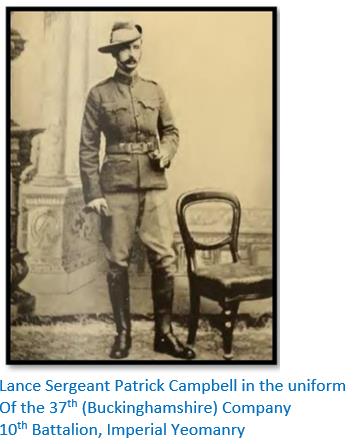
Returned to his family in Kensington Square, London in 1895. Joined the 37th (Buckinghamshire) Company, 10th Battalion, Imperial Yeomanry in 1900 as a volunteer. Killed in Action after being back in South Africa less than a month in an engagement at Boshof in the Free State on 5 April 1900.
(3) Christison, Thomas James (1863 – 1932) No 164
Joined the Pioneer Corps on 14 July 1890 having previously been attested into the BSA Co Police (No 484) as one of Rhodes ‘Apostles.’ Appointed to A Troop.[ix]
Born in Scotland 2 June 1863 he travelled to South Africa in 1883 and joined the Cape Town Highlanders where he was Lieutenant, acting Adjutant before being promoted to Captain and Adjutant and having the nickname of ‘Bins.’ Resigned to join the BSA Co Police.
Employed by the BSA Co as Mining Commissioner and Registrar of Claims 1890 – 1895. Volunteered for duty in Manicaland and took part in the battle of Macequece (Massi Kessi) in 1891 against the Portuguese.[x]
He was appointed a Justice of the Peace for Salisbury district on 12 May 1891. Appointed Lieutenant in C Troop of the Salisbury Horse in 1893. Appointed Mining Commissioner at Bulawayo before taking eight months leave in March 1894.
On his return, appointed to the Mines Office in Salisbury and Justice of the Peace. In the 1896 Mashona / Matabele Rebellion promoted to Captain and adjutant of the Salisbury Field Force.
Adrian Darter in his book Pioneers of Mashonaland tells of an incident in which Christison discharged his revolver in Darter’s direction, unwittingly forgetting that he had put the revolver away loaded in one chamber: “There was a report and the earthenware pot I was sitting over and dropping the sweet potatoes in, fell shattered to atoms.”[xi]
Left Rhodesia in 1898 and went to Australia, returning to Northern Rhodesia (now Zambia) in 1902 where he lived at Mkushi and was appointed as the representative of the Rhodesia Native Labour Board. Later employed by Broken Hill Township Management Board.
Died at Broken Hill (now Kabwe) on 30 October 1932. Married Catherine Anastasia O’Brien at Cape Town in 1899, no children.[xii]
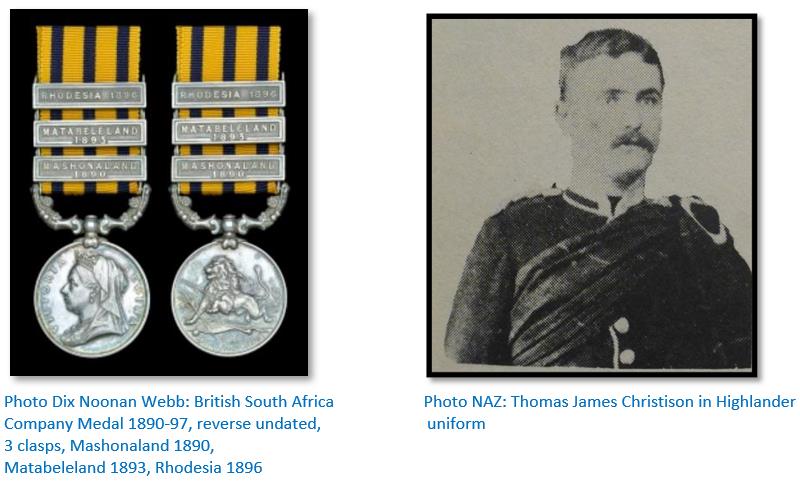
(4) (Later Sir) Coryndon, Robert Thorne, K.C.M.G. (1870 – 1925) No 166
Joined the Pioneer Corps on 14 July 1890 having previously been attested into the BSA Co Police (No 485) as one of Rhodes ‘Apostles.’ Appointed to A Troop.
He had joined the BSA Co on 29 October 1889 and was attached to the Bechuanaland Border Police on 9 November 1889.
Following the disbandment of the Pioneer Corps he prospected for a short period after disbandment before being employed as a draughtsman in the Surveyor-General’s office, Salisbury in 1891-92. Resigned to go big game hunting in the Zambesi Valley in 1892 where he shot two white rhinos for the Rothschild Collection.
Then worked in Salisbury where he was a Sergeant in the Salisbury Horse during the 1893 Matabele War. Promoted to Lieutenant in the mounted troop of the Rhodesia Horse Volunteers during 1896 Matabele / Mashona Rebellions.
He was in command of a party of Beal’s Scouts from Salisbury and on the 15th of June 1896 was in an engagement near the Hunyani (now Manyame) river in which 30 Mashona were killed and a kraal destroyed.
His brother, John Selby Coryndon, was killed at Chena’s kraal on the south bank of the Umfuli (now Mupfure) river opposite Mashayamombe’s kraal on 11 October 1896.
In 1897 appointed to private secretary of Cecil Rhodes and in September appointed British Resident and BSA Co representative in Barotseland with headquarters at Kazungula. From 1900 – 06 he was Administrator of Barotseland at Kalomo.
Colin Harding in his book Frontier Patrols writes: “It is worthy of note that at one period of the early occupation of North Western Rhodesia nearly every official was a British South Africa policeman or could refer to his past service in that corps. Foremost in this admirable fraternity was the Administrator, Major Coryndon.”
In 1907 appointed as British Resident in Swaziland (now Eswatini) before in 1918 being appointed Governor of Uganda and in 1923 Governor of Kenya. Awarded K.C.M.G.
Born in Queenstown in the Cape Colony in 1870 and educated at Cheltenham College. Died 1 February 1925. Married Miss Worthington in 1909. No children.
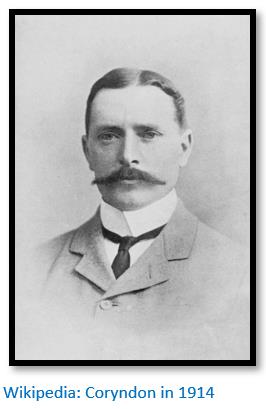
(5) Cornwall, William Lundie (unknown) No 163
Joined the Pioneer Corps on 14 July 1890 having previously been attested into the BSA Co Police (No 486) as one of Rhodes ‘Apostles.’ Appointed to A Troop.
Birth date unknown, was a son of Moses Cornwall, Sheriff of Griqualand West.
Following the disbandment of the Pioneer Corps was appointed Registrar of Mining Claims. By July 1891 he was in business in Fort Salisbury as ‘W.L. Cornwall, Secretarial Agent, Auctioneer and Sworn Appraiser’ in partnership with Herbert John Morris (No 63) and Patrick W. Campbell (No 163)The partnership dissolved in September 1895.
Cornwall served as a Captain and adjutant in the Salisbury Horse in the Mashona Rebellion of 1896 and was in command of a patrol in the Chishawasha area from 22nd to 28th of July. This patrol was engaged in heavy fighting in broken country but successfully stormed Ruoko’s kraal, having three men wounded. Many Mashona rebels were killed and Cornwall brought in 100 bags of grain.
At some later date he left Rhodesia and settled at Muizenberg, Cape Town.
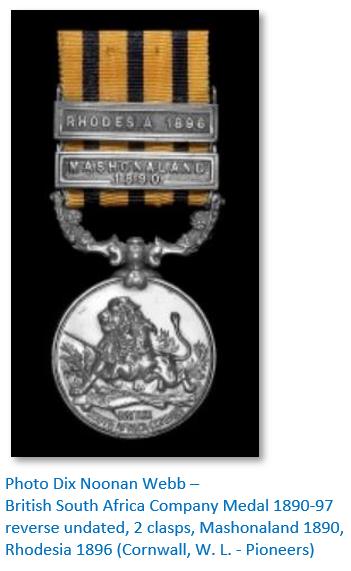
(6) Durrell, Walter Delaney[xiii] (? – 1898) No 167
Joined the Pioneer Corps on 14 July 1890 having previously been attested into the BSA Co Police (No 487) as one of Rhodes ‘Apostles.’ Appointed to B Troop and then temporarily to A Troop next day as a Trooper.
Previously worked on the Union shipping line. In 1882 was wounded at Tel-El-Kebir in the Anglo-Egyptian War.
In 1891 prospected in the Mazoe Valley before mining on the Revue Divide, Penhalonga in 1892.
Died in Rhodesia in 1898
(7) Eliot, Algernon Ernest Albert[xiv] (1867 - 1945) No 169
Another of Rhodes ‘Apostles’ he joined the Pioneer Corps on 14 July 1890 having previously been attested into the BSA Co Police (No 488) as one of Rhodes ‘Apostles.’ Appointed to B Troop and then temporarily to A Troop next day as a Trooper.
Born in Cape Town on 19 April 1867. Following disbandment of the Pioneer Corps he prospected in Mashonaland.
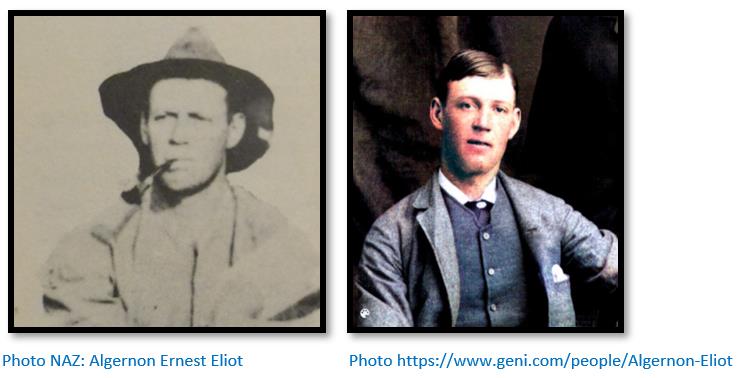
Served in the British forces during the Anglo-Boer War of 1899 – 1902.
Saw active service at the Battle of Mons which was the first major action of the British Expeditionary Force (BEF) in the First World War. Lived in Kimberley for much of his life.
He was a plant superintendent in the Transvaal when he died on 10 April 1945 in an accident which caused him multiple injuries. Married Ada Addison at Kimberley in 1895 and had four sons and four daughters.
(8) Ehlert, Frederick (? – 1896) No 168
Joined the Pioneer Corps on 14 July 1890 having previously been attested into the BSA Co Police (No 489) as one of Rhodes ‘Apostles.’ Appointed to B Troop and then temporarily to A Troop next day as a Trooper.
He came from the Kimberley area. Following disbandment of the Pioneer Corps he prospected in the Mazoe Valley. In the Matabele War he served as a gunner in the Salisbury Horse and was slightly wounded at the Battle of Bembesi in November 1893.
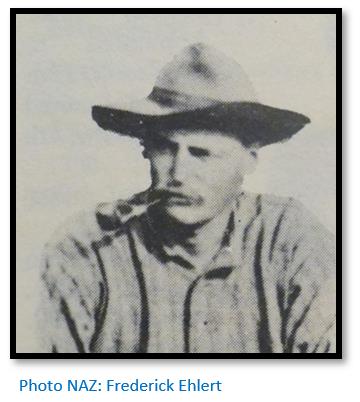
Murdered at Filabusi at the start of the Matabele Rebellion on 25 March 1896 with his companions A. Ayerst and J. Jeffries.
(9) Featherstonehaugh, Henry Westcott (1866 – 1917) No 170
Joined the Pioneer Corps on 14 July 1890 having previously been attested into the BSA Co Police (No 490) as one of Rhodes ‘Apostles.’ Appointed to B Troop and then temporarily to A Troop next day as a Trooper.
He served in the Bechuanaland Border Police (BBP) prior to 1889. In the 1893 Matabele War he served with Raaff’s Rangers who left from Fort Tuli on the 9th October and linked up with Goold-Adams force at Macloutsie. The combined force left on 11th October and followed the Macloutsie river to the Tati – Bulawayo road drift. They were joined at the Shashi river by Chief Khama’s forces on the 13th October. They arrived at Empandeni on 3rd November and left for Bulawayo on 6th November arriving at Bulawayo on the 15th November.
During the Matabele / Mashona 1896 rebellions he served as a Sergeant in Robertson’s Cape Volunteers[xv] which fought well at Ntaba-zika-Mambo[xvi] and in the Matobo Trooper as part of Plumer’s Matabeleland Relief Force (MRF)
In the 1899 – 1902 Anglo-Boer War saw active service as a trooper in Cullinan’s Horse.
In the First World War he served as Officer in charge of Transport and Remounts. Invalided out of the army.
Died at New Modderfontein, Benoni, Transvaal on 17th February 1917. His occupation is listed as mining overseer.
Married Marion Matilda Stanford and had three sons and two daughters.
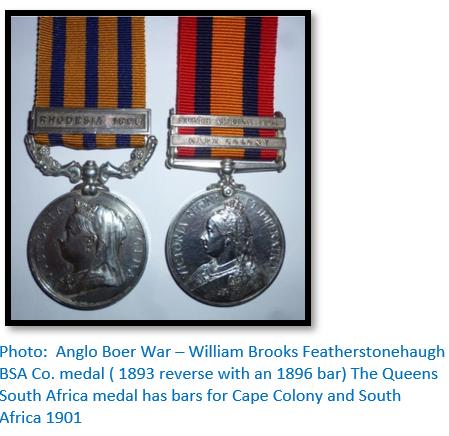
(10) Grimmer, John Robert (? – 1902) No 171
Joined the Pioneer Corps on 14 July 1890 having previously been attested into the BSA Co Police (No 491) as one of Rhodes ‘Apostles.’ Appointed to B Troop and then temporarily to A Troop next day as a Trooper.
In 1891 he was private secretary to Cecil Rhodes.
He was a corporal in the Salisbury Horse during the 1893 Matabele War.
During the Matabele / Mashona 1896 rebellions he served as a Trooper in the Grey’s Scouts.
Hickman writes: “on 2 October 1896 a terrible dynamite explosion took place at Bulawayo near the police camp. Grimmer had just taken a horse from the remount lines and mounted to leave, when he was blown clean off its back and three other horses were killed by flying stones.”
By 1897 he was managing Rhodes Inyanga Estates.
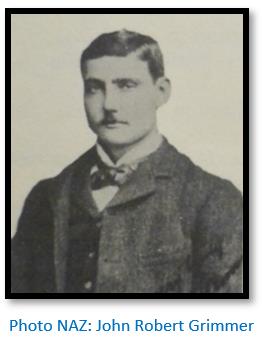
Born in Kimberley, son of Dr W. Grimmer. Died of fever at Caledon in the Cape Colony in June 1902 soon after Cecil Rhodes death on 26 March 1902. Hickman writes that it was said that Rhodes left Grimmer £10,000 in his will.
Marshall Hole in Old Rhodesian Days tries to analyse the Rhodes – Grimmer friendship that was due, he thought, to a shared passion for the open veldt, for distance and open spaces. He wrote: “Grimmer, for example - good natured to a fault and a fine specimen of a young colonial, was a solid, taciturn man, with no special intellectual gifts or business acumen - not at all the sort of person one would have expected Rhodes to pick out for close friendship. It is said that someone once tried to extract from Rhodes what qualities he saw in Grimmer that made him choose him, first as his secretary and afterwards as his constant travelling companion. ‘You see’ replied Rhodes after a moment thought, ‘Grimmer is such a hustler with mules.’
Marshall Hole goes on: “I saw a good deal of Grimmer after Rhodes's death and realized that the world had come to an end for him, and in fact he died, some think of a broken heart, within a few weeks of his patron.”
(11) MacRobert, John Murie (1863 – 1897) No 172
Joined the Pioneer Corps on 14 July 1890 having previously been attested into the BSA Co Police (No 492) as one of Rhodes ‘Apostles.’ Appointed to A Troop.
Born in Worcester, Cape Colony and educated at Diocesan College, Cape Town.
Employed at Kimberley as an Excise Officer where he met Rhodes and was persuaded to join the march to Mashonaland.
Following disbandment of the Pioneer Corps he prospected in the Mazoe Valley and at Hartley Hills with James Adair Campbell, ex-Lieutenant in the Pioneer Corps, and J. ‘Jill’ Fraser.
Hickman writes: “It appears that they had shot a native under circumstances at present not known and then camped in the vicinity of Chief Mashayamombe’s kraal. They were smoking in bed when they heard horses and voices at night. Their visitors were Major P.W. Forbes and Lieutenant S.W.B. Shepstone, his interpreter. Campbell in a note relates that they got up and gave them food.
They had come from Salisbury to answer to our numerous complaints and MacRobert’s case in particular, and on arrival at Hartley had followed us up…Forbes was Fraser’s commanding officer and he suggested to MacRobert and me that we should tell him the whole story in case Shepstone found out by talking to the boys. This we did in confidence.
Forbes told us that he had to get back early the next day and would I, through ‘Jill’ order Mashayamombe and his headman down from the hills and give him the following words of the Government. It was to the effect that if his people did not cease thieving from the Europeans, the Government would retaliate on the chief. In other words, the chief and the headman would be responsible for the conduct of their people.
Forbes left at dawn the next morning and I sent ‘Jill’ and our carriers into the hills and in due course the chief and many of these people assembled. I laid it on thick. ‘On my return to Hartley Hills I found my hut had been broken open and everything I had stolen.
It looks therefore, as if the shooting incident had something to do with the thieving propensities of the Mashona.”[xvii]
Worked in the Mines department. Served as a Lieutenant in the Gwelo Volunteer Corps under Captain Gibbs[xviii] during the 1896 Matabele / Mashona Rebellion.
He was a successful property owner and gold prospector. He died from a gunshot wound in his room at Salisbury on 10 June 1897.[xix] The coroner’s verdict was ‘suicide during temporary insanity’ but doubt was cast on this verdict by a later confession made to a priest by one of his partners.
(12) Nesbitt, William M (? – 1929) No 173
Joined the Pioneer Corps on 14 July 1890 having previously been attested into the BSA Co Police (No 493) as one of Rhodes ‘Apostles.’ Appointed to A Troop.
Son of Colonel Nesbitt – one of five Troopers with the name Nesbitt in the Pioneer Corps.
Following disbandment of the Pioneer Corps he prospected in the Mazoe Valley.
Hickman writes the following: “During the Boer War of 1899 – 1902 R.S.S. Baden-Powell was charged with the duty of defending Mafeking in the event of hostilities. He had under his command a number of armoured trucks which had been conditioned in the railway workshops at Bulawayo and were manned by members of the B.S.A. Police. When war appeared inevitable, Nesbitt was sent south from Mafeking in charge of an armoured train in which was a large group of women and children refugees. He was returning with two guns and a supply of ammunition sent by the Cape authorities, travelling in an armoured carriage and a truck and reached Vryburg safely on 11th October 1899. He had a guard of 15 men and at Vryburg his carriage and truck were attached to a pilot engine and drove on towards Mafeking. But at Kraaipan, about 40 miles south, the engine was derailed and when Nesbitt and his men detrained to put the line in order, they were fired upon in the dark and several men wounded. These were the first shots of the Boer War. At daybreak on the 12th, it was seen that about 100 Boers were sniping from a sluit, and then a gun firing 40-pound shells came into action. Nesbitt held on for two more hours until the situation was hopeless and he surrendered. He was himself wounded in the thigh and the only man to escape was Flowerday, the civilian engine-driver. The loss was a severe one to Baden-Powell, who in some accounts is said to have blamed Nesbitt for falling into a trap. If this is true it seems unjust, especially as there had been no declaration of war. Nesbitt was taken as a prisoner of war to Pretoria; for the rest of his life, he walked with a limp.”[xx]
Died at Johannesburg in 1929.
(13) O’Meara,[xxi] Bulkeley[xxii] Ernest Adolphus D.S.O. (1 Feb 1867 – 1916) No 174
Joined the Pioneer Corps on 14 July 1890 having previously been attested into the BSA Co Police (No 494) as one of Rhodes ‘Apostles.’ Appointed to A Troop and then temporarily to B Troop on the 26th July as a Trooper.
Hickman writes that in October 1891 following disbandment of the Pioneer Corps and his discharge: “He left Salisbury in company with sub-lieutenants M.H.G Mundell and C.J. Harford for Beira. They had great trouble with their carriers, no less than three parties deserting. However, when they reached the Pungwe river at M’pandas they were taken on by a Portuguese customs launch as far as Neves Ferreira,[xxiii] and from there to Beira by lighter. The ship, which was to take O’Meara to Cape Town, the Limpopo, came with Cecil Rhodes as a passenger. On its southward journey to the Cape most people slept on the deck because accommodation was so limited.”
O’Meara was then employed as a land surveyor at the De Beers and Dutoitspan Mines at Kimberley.
In the Anglo-Boer War he served first in the Kimberley Town Guard, then transferred to the Intelligence department as Intelligence Officer for Griqualand West and was SO1 to the Vryburg and Carnarvon Columns. Then he became Press Censor, Interpreter and Intelligence Officer at Oudtshoorn under Inspector-General Western. Appointed Captain.
Mentioned four times in despatches and created a Companion of the Distinguished Service Order [London Gazette: 19 April 1901] ‘Bulkeley Ernest Adolphus O’Meara, Captain, Kimberley Town Guard.’ The D.S.O. was presented in South Africa.
Subsequently appointed Government Surveyor for the Cape and Transvaal colonies working from Johannesburg.
He was a keen sportsman, including big game shooting.
Born at Umballa, India and educated at Dulwich College and King’s College School, Somerset House, London. Died 31 August 1916.
(14) Seward, George Ernest (? – 1896) No 176
Joined the Pioneer Corps on 14 July 1890 having previously been attested into the BSA Co Police (No 495) as one of Rhodes ‘Apostles.’ Appointed to A Troop.
Sentenced to 14 days imprisonment (7 days remitted) and fine of 10 shillings for being asleep on outlying picquet duties.
Following disbandment of the Pioneer Corps he went into business as a secretary and accountant in partnership with P.W. Campbell (No 483) and W.L. Cornwall (No 486)
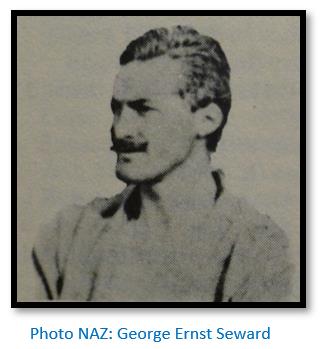
In the 1893 Matabele War he was a Trooper on the Maxim gun in the Salisbury Horse.
Murdered, along with Colin Cato, at Filabusi on 25 March 1896, whilst working for Mallet and Hodson on the Ancients Reef.
(15) Steir, William Keppel (? – 1901) No 175[xxiv]
Joined the Pioneer Corps on 14 July 1890 having previously been attested into the BSA Co Police (No 496) as one of Rhodes ‘Apostles.’ Appointed to B Troop.
Previously served in Egypt with the 3rd Dragoon Guards (Queen’s Bays) and in the Cape Mounted Rifles (CMR)
Following disbandment of the Pioneer Corps he was prospecting at Eiffel Flats in December 1890 in the area of the Cam and Motor Mine.
In the 1893 Matabele War he was a Corporal in the Salisbury Horse but allowed to take his discharge at Charter to take up a commission as Lieutenant in the dismounted troop of the Victoria Rangers under Captain Delamere. At the battle of Bembesi[xxv] he and his commanding officer led a patrol of 100 troopers and followed up the retreating impi’s.
Served with the Salisbury Field Force as Captain during the 1896 Matabele / Mashona Rebellion.
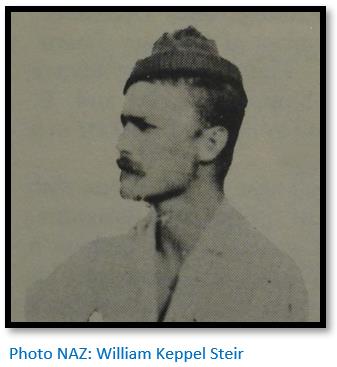
During the 1899- 1902 Anglo-Boer War he served with Kitchener’s Fighting Scouts before transferring to the Intelligence staff. Killed in Action near Warmbaths, Transvaal in late 1901.
References
R. Cary. The Pioneer Corps, Salisbury, 1975
A. Darter. Pioneers Of Mashonaland. Books of Rhodesia, Bulawayo, 1977
A.S. Hickman. Men who made Rhodesia. British South Africa Company, Salisbury 1960
H.F. ‘Skipper’ Hoste. Gold Fever. Pioneer Head, Salisbury, 1977
A.G. Leonard. How we made Rhodesia. Books of Rhodesia, Bulawayo, 1973
Notes
[i] Gold Fever, P49-50
[ii] H.F. ‘Skipper’ Hoste. Rhodesia in 1890. Rhodesiana Publication No 12, September 1965. P1 – 26
[iii] Captain Maurice Heany commanded A Troop; Captain Henry Francis ‘Skipper’ Hoste commanded B Troop
[iv] Men who made Rhodesia, P92
[v] Pioneers of Mashonaland, P127
[vi] How we made Rhodesia, P92
[vii] For more details see the article Patrick Campbell, husband of Mrs Patrick Campbell who went to Mashonaland and was killed in the Anglo-Boer War 1899-1902 under Harare on the website www.fieldguide.com
[viii] It is clear that L.S. Jameson did not enjoy administration and this is probably why he delayed assuming the post of Administrator
[ix] Hickman says Christison served in B Troop
[x] See the article How Mutare and Manicaland were annexed from the Portuguese under Manicaland on the website www.zimfieldguide.com
[xi] The Pioneers of Mashonaland, P33
[xii] Hickman states Christison died at Cape Town
[xiii] Hickman records as Durell, A
[xiv] Hickman records as Elliott, A.E.A.
[xvi] See the article the Battle of Ntaba zika Mambo, Manyanga or Mambo Hills under Matabeleland North on the website www.zimfieldguide.com
[xvii] Men who made Rhodesia, P352
[xviii] See the article Fort Gibbs and Sgt William Maxwell's grave under Midlands on the website www.zimfieldguide.com
[xix] Hickman says he died near Hartley Hills on 10 June 1897
[xx] Men who made Rhodesia, P553
[xxi] O’Meara – additional information from https://www.angloboerwar.com/index.php/medals-and-awards/british/1884-di...
[xxii] Robert Cary states his first name as Buckley and that he served in East Africa – I have relied on Anglo-Boer War website information.
[xxiii] Neves Ferreira was higher up the Pungwe than Fontesvilla whish became the railhead for the Beira Mashonaland Railway
[xxiv] In the Pioneer Corps nominal roll his surname is spelt Stier
[xxv] For details see the article Battle of Bembesi (called Egodade by the amaNdebele) under Matabeleland South on the website www.zimfieldguide.com
